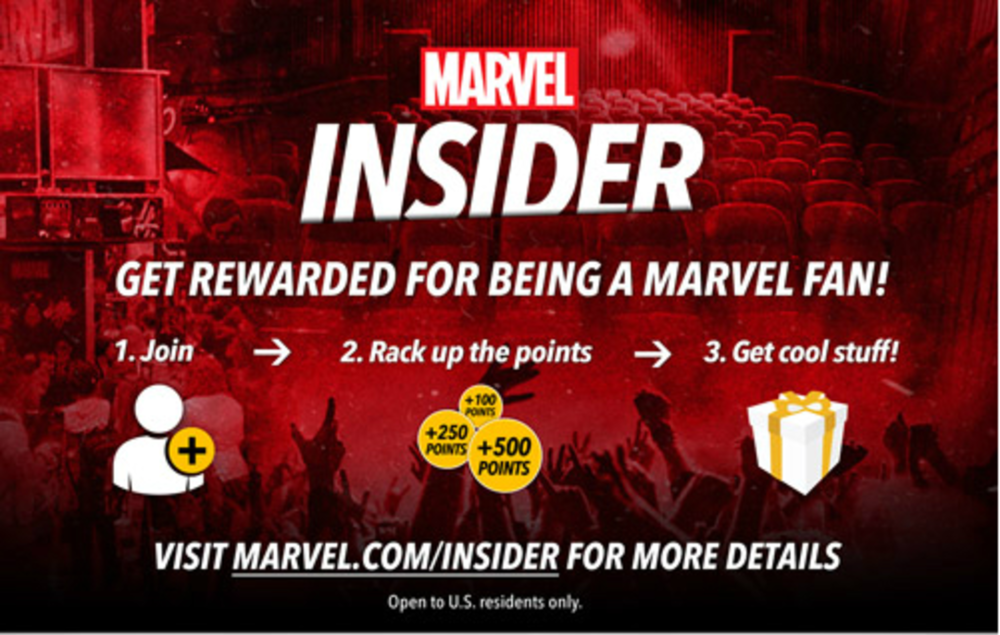More than a week has passed since San Diego Comic-Con, and people are still talking about the news and trailers that came out during the event. However, the announcement of Marvel Insider, the entertainment giant’s first loyalty program, was lost somewhere in the midst of the post-con news frenzy.
Marvel released its second Doctor Strange trailer during the convention, which has garnered some 12 million views in the 10 days since. The company also released several teaser trailers for upcoming TV series, and generated numerous headlines from a number of Comic-Con exclusive reveals. This is all evidence of an obvious truth: Marvel is an uncommonly powerful brand. It was powerful even before Disney’s $4 billion acquisition of the company in 2009. In the 77 years since its founding, Marvel has earned zealot-levels of devotion and fandom.
Given that the structure of Marvel content, which is episodic in nature, loyalty has never been much of a problem. So the question then becomes, why has Marvel decided to introduce a loyalty program to a base that has been intensely loyal for years?
The answer: by making the program more of a nexus of the brand’s products than a rewards engine for brand-agnostic customers.
“Our fans have such an appetite for everything that we do, and [Marvel Insider] really helps us bring the breadth of the entire Marvel Universe to them,” Peter Phillips, EVP and GM of interactive and distribution at Marvel, said in an email interview. “The program is a way to let fans know that they can do more than just watch the [Luke Cage] show, they can also play the Luke Cage character in our Marvel Puzzle Quest mobile game.”
On the surface, this doesn’t sound too far off from other, more standard loyalty programs, but Marvel Insider is a functional departure from many of your run-of-the-mill rewards programs in that the emphasis is on organic engagement. “You get rewarded for what you’re already doing. It’s really about fan engagement rather than points for purchase, which is normally what you see with a lot of loyalty programs,” Phillips said.
What does Marvel mean by engagement? Almost anything, apparently.
Marvel Insider rewards points for watching videos, listening to podcasts, following Marvel social media accounts, buying Marvel products. Members (who sign up for free) are literally rewarded for doing exactly what they’re doing anyway, and have done for the greater part of the century. By integrating with fans’ social media accounts, Marvel will ostensibly now have insight into the digital behavior of its most passionate fans.
The program is too new to have had a significant impact on Marvel’s business, but it nonetheless has serious potential to alter the function of loyalty programs in the digital age, especially for entertainment brands.
“Right now is the dawn of a new era that shows how loyalty programs can transcend industries beyond traditional industries like retail, travel and hospitality, and credit cards. Multichannel programs open new doors for the comics industry,” says Emily Rudin, SVP of Client Success at CrowdTwist, the loyalty and engagement solutions provider Marvel partnered with to develop Marvel Insider.
Indeed, taking a multichannel approach to loyalty programs is more than a viable strategy, it’s optimal in today’s consumer landscape.
Like many entertainment brands, Marvel’s product portfolio has expanded considerably over the last 20 years. Through licensing its collection of characters, Marvel’s brand has grown in tandem with the general diversification of media. Comics became toys, which became TV shows, which became novels, which became videogames, which became movies, apps, websites, social media, etc. As these channels proliferate—and they will continue to do so—encouraging, and rewarding engagement with the brand across all of them becomes a priority. “Multichannel loyalty programs allow media brands to motivate fans to take all kinds of actions—introducing them to new product lines, deepening their engagement in the ones they already love, and encouraging their advocacy to their networks, which, in turn, wins new customers,” Rudin says. “Brands can track all of the data about these actions to learn more about their customers and offer them better experiences.”
For Marvel it seems, the key to better experiences lies in the common denominator in all of its recent successes: fun.
“We wanted to create this feeling of being a kid at the arcade. Not only are you using your tickets to get really cool prizes, but you’re also having a ton of fun playing games as you’re earning those tickets,” Phillips said.








